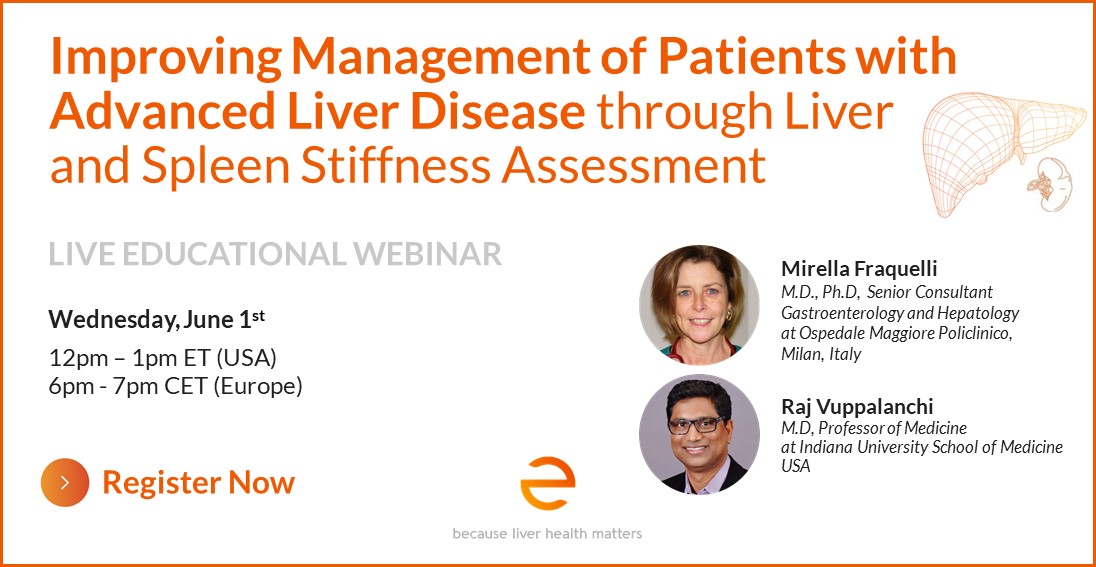Echosens is pleased to provide a recap of our educational webinar:
featuring Mirella Fraquelli, M.D., Ph.D., senior consultant, Gastroenterology and Hepatology, Ospedale Maggiore Policlinico, Milan, Italy, and Raj Vuppalanchi, professor of Medicine, Indiana University School of Medicine, United States.
The webinar used case studies to examine the impact of using FibroScan®, a rapid, non-invasive point of care examination that can cost-effectively identify individuals who are asymptomatic and undiagnosed for liver disease and portal hypertension.
FibroScan is powered by liver stiffness measurement assessed by vibration-controlled transient elastography (LSM by VCTE™), controlled attenuation parameter (CAP™) and spleen stiffness measurement (SSM by VCTE™).
Case Study
A 53-year-old presented with liver enzyme elevations and features of metabolic syndrome, pre-diabetes and thrombocytopenia. After quitting drinking for four months, his only symptoms were fatigue with no history of liver decompensation. At this point, it was determined that the patient had undiagnosed Type 2 diabetes and thrombocytopenia.
The FibroScan® evaluation showed spleen stiffness of 78.8, which is consistent with cirrhosis and portal hypertension. The physician determined that the patient had metabolic associated fatty liver disease (MAFLD) and recommended an esophagogastroduodenoscopy (EGD).
Guidelines
The webinar also covered the latest Baveno VII guidelines fully supporting the effectiveness of FibroScan® technologies for the management of patients with advanced chronic liver disease, providing a powerful level of support for its use among specialists. Specifically, Baveno VII renews consensus in personalized care for patients with compensated advanced chronic liver disease (cACLD), clinically significant portal hypertension (CSPH) and esophageal varices.
The guidelines suggest using LSM to stratify patients according to liver decompensation measurements with the goal of preventing further decompensation and death. The guidelines also recommended follow-up that includes repeating LSM every 12 months. Decreasing LSM substantially reduced risk of decompensation and liver-related death.
The guidelines also recommend LSM by VCTE™ for monitoring cACLD patients, with clear cut-offs provided to identify substantially reduced risk of decompensation and liver-related death. The guidelines for monitoring cACLD patients state the test can be repeated every 12 months. A clinically significant decrease in LSM, which is associated with substantially reduced risk of decompensation and liver-related death, can be defined as a decrease in LSM of ≥20% associated with LSM<20 kPa or any decrease to a LSM<10 kPa.
It becomes evident that more liver stiffness data enables clinicians to be more confident in using cut off values, avoiding endoscopy and determining risk of death or transplant due to underlying portal hypertension.
New Tool for Hepatologists
Dr. Vuppalanchi expressed enthusiasm for FibroScan® as an important advance for clinicians to measure spleen stiffness. He suggested that LSM should be the first line test and SSM the second line test as a two-step approach that adds value by avoiding endoscopies by 39%. The tool is also valuable for prognostics, with LSM predicting liver decomposition and death—and predicting survival better than biopsy. He notes that SSM outperformed LSM in predicting significant clinical outcomes.
“This is a new and exciting tool for hepatologists that enables a shift from invasive to non-invasive ways to measure liver and spleen stiffness, with no risk for the patient,” he concludes.


